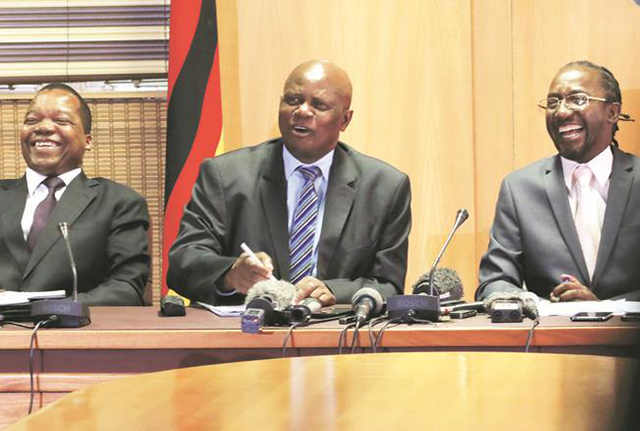New indigenisation framework unveiled


Finance and Economic Development Minister Patrick Chinamasa shares a joke during a Press conference while flanked by Youth, Indigenisation and Economic Development Minister Patrick Zhuwao (right) and Reserve Bank of Zimbabwe Governor John Mangudya in Harare yesterday
Felex Share Senior Reporter
GOVERNMENT yesterday unveiled a new framework to the Indigenisation and Empowerment Policy containing a cocktail of measures expected to complement other initiatives to attract local and Foreign Direct Investment.
Over the past few weeks, Finance and Economic Development Minister Patrick Chinamasa and his Youth, Indigenisation and Economic Empowerment counterpart Patrick Zhuwao appeared to differ on the framework and last week had to cancel a joint media briefing they had planned.
Also read:
The ministers, however, managed to find each other under the direct supervision of Acting President Phelekezela Mphoko and yesterday held a joint Press conference with Reserve Bank of Zimbabwe Governor Dr John Mangudya to unveil the new indigenisation framework developed in line with Zim-Asset and the 10-Point Plan for Economic Growth enunciated by President Mugabe in his State of the Nation Address last year.
The guidelines also put into effect pronouncements by President Mugabe during the Zanu-PF 15th Annual National People’s conference last month that Government would not tolerate companies that refuse to comply with indigenisation this year.
Minister Zhuwao said they had now agreed on procedures and guidelines for implementing the Indigenisation and Economic Empowerment Act (Chapter 14:33) as directed by Cabinet.
“As we move forward, the emphasis is on implementation of the indigenisation law starting with the submission of the indigenisation implementation plan, which every company affected should submit as soon as possible but no later than 31 March 2016,” he said.
“We want to emphasise that compliance with the indigenisation law is the cornerstone of Government policy as given to it by Zanu-PF.”
He said models that allowed the achievement of Zim-Asset goals within the legislative framework of the Indigenisation and Economic Empowerment Act would be developed in line with appropriate line ministries.
As such, Minister Zhuwao said, stakeholders should engage with the respective sector ministries for input towards the development of the models.
Minister Chinamasa said there had been a “robust debate” before an agreement was reached on the framework.
“We have now come up with an improved product, which is very conducive for investment,” he said. “It’s a milestone in the turnaround of the economy. We have now closed ranks to emphasise implementation. This was the last policy requiring clarity and now that we have done it, we simply need to implement. We have now clarified the position and if there are any difficulties they know where to go.”
Minister Chinamasa said certain sectors would be reserved for local people to give space to “our people to grow and prove their expertise through that limited protection.”
“To emphasise a local participation in the economy by indigenous people, is a must,” he said.
“Without that we would have no economy. Foreign investment will come to complement what local participants are doing. A lot of models are going to be worked on so that we enhance local participation. We know our bottlenecks are funding and entrepreneurship and we will find ways of addressing them.
The Finance Minister said the new guidelines were an “improved text” from what he had gazetted last week.
“We now have a refined document I am lending my weight to this document,” he said.
According to new frameworks, a raft of measures will be introduced and they include “invoking Section 17 of the Act albeit in a manner that recognises businesses that are complying with the legislation through the provision of indigenisation legislation compliance rebates, indigenous shareholding rebates and rebates for achieving socially and economically desirable objectives.”
“A maximum possible 100 percent indigenous compliance and empowerment rebate score will mean that a business has effectively complied with indigenisation and economic empowerment programme and does not need to pay the indigenisation compliance and empowerment levy,” reads the framework.
To economically empower indigenous Zimbabweans, the framework states, “empowerment credits may be taken into account in achieving the 51 percent indigenisation threshold.”
In the resource based sector, Government designated entities shall continue acquiring 51 percent equity in businesses exploiting natural resources at no monetary consideration serve for the contribution of the resource being exploited.
In the non-resource based sector, General Notices (459 of 2011 and 280 of 2012), which were developed by sector specific committees taking into consideration the strategic direction of those sectors will continue being operational.
No new non-indigenous business will be allowed to invest in the reserved sector unless, “under special cases as determined by line ministries and approved by Cabinet.”
The indigenisation compliance and empowerment levy will be levied on all business and the money would go into a Fund that will support empowerment projects for locals.
The amount is yet to be fixed.
The market friendly and flexible framework includes the offering of empowerment credits and rebates to investors, articulation of the indigenisation compliance and empowerment levy and the requirement that all Government departments, statutory bodies and local authorities buy at least 50 percent of their goods from local businesses.
Also re-emphasised by the new framework is the indigenisation of businesses in the resources based sector, non-resources based sector and reserved sector, procedures for ensuring compliance with the legislation and the indigenisation compliance process flow.
All companies that have not yet submitted their indigenisation plans are required to do so—through the Zimbabwe Investment Authority—by March 31.








Comments